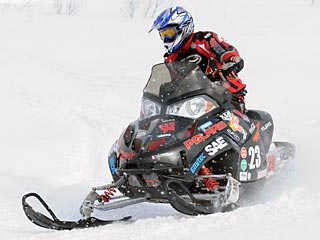UW-Madison team ‘zaps’ competition with electric snowmobile
The UW–Madison Clean Snowmobile team blew the competition out of the snow at the Society of Automotive Engineers (SAE) Clean Snowmobile Challenge (CSC) in Houghton, Mich., March 10-15.

UW-Madison engineering student Mike Maney rides Bucky EV, the winning electric snowmobile at the 2008 SAE Zero-Emissions Clean Snowmobile Challenge, during the handling event in Houghton, Mich. The UW–Madison team earned numerous top awards for its zero-emissions electric snowmobile.
During the six-day competition, the UW–Madison team unveiled its new all-electric snowmobile, Bucky EV, which captured top honors in the zero-emissions competition.
CSC teams re-engineer existing snowmobiles to improve emissions, noise and performance while remaining cost-effective. SAE has designated two categories of competition: internal combustion and zero emissions. UW–Madison has participated in the internal-combustion CSC since 2002, claiming first place in 2004 and 2006. This is UW–Madison’s first entry in the zero-emissions event.
Snowmobiles in the zero-emissions event, which began in 2004, are completely electric. SAE partnered with the National Science Foundation (NSF) for the event at the request of VECO Polar Resources, NSF support contractor in Greenland.
Bucky EV uses 84, 28-volt lithium-ion Milwaukee Tool battery packs. The power is routed through an Azure Dynamics motor controller coupled to a Delphi EV1 motor — the same motor that powered the GM EV1 electric car. “We can charge these batteries in half an hour,” says team captain Nick Rakovec. “If the NSF takes it to Greenland, they’ll be able to recharge it quickly.”
On a single charge, the 100-horsepower electric sled can run nearly 20 miles, shattering the range goal of 10 miles. During the endurance portion of the competition, the Bucky EV held a 20-mph pace for 17.2 miles — nearly 10 miles past the second-place finisher — before the team voluntarily stopped to ensure efficient recharging. The sled also outshone the competition in acceleration and sound (at 50 feet, the sled produces a quiet 55 decibels).
“After test-riding the Bucky EV, all of the organizers and judges dismounted with huge smiles on their faces,” says faculty associate Glenn Bower, the team’s adviser. “Some simply laughed in disbelief.”
The goal for zero-emissions teams is to help scientific research in Greenland and Antarctica, where gas-powered vehicles can contaminate air and snow samples. The NSF has plans to test the Bucky EV at one of its Arctic study camps in Greenland this summer. In addition, the NSF will arrange for one student to visit the camp for a week.
“It’s an incredible machine,” says Tracy Dahl of Polar Field Services, representing NSF. “The thing rips.”
The UW–Madison team also competed in the internal combustion engine category with the Bucky 750, a sled that was converted and calibrated to operate on E85 (85 percent ethanol and 15 percent gasoline). The Bucky 750 uses a 750 cc displacement four-valve Weber four-stroke engine producing 60 horsepower. The UW–Madison engineering team added prototype catalysts and mufflers to make the snowmobile extremely clean and quiet. Overcoming an early wiring failure during the endurance event, the Badgers clawed their way to a fifth-place finish while capturing awards for best design and the most practical solution balancing cost, noise and emissions.
Awards for Bucky EV:
- The Society of Automotive Engineers Award for Best Electric Design
- Denso Corp. Award for Best Ride
- First Place for Best Technical Paper
- First Place for Oral Presentation
- Caterpillar Corp. Innovation Award
- Veco Polar Resource Range Event Award
- NGK Spark Plugs/NTK Sensors Cold Start Award.
Awards for Bucky 750:
- SAE Milwaukee Chapter Award for Fifth Place
- The Society of Automotive Engineers Award for Best Internal Combustion Design
- The Blue Ribbon Coalition Award for Most Practical Solution
- Third Place for Best Technical Paper
- Second Place for Oral Presentation.
